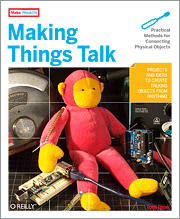Usman Haque, Adam Somlai-Fischer: Low Tech Sensors and Actuators for Artists and Architects (2005)
Filed under manual | Tags: · interaction design, sensors, technology

Low Tech Sensors and Actuators investigates how low-tech sensors and interactive actuators can be produced inexpensively from hacked toys and devices.
by Usman Haque, http://www.haque.co.uk, and Adam Somlai-Fischer, http://www.aether.hu
a research project sponsored and commissioned by FACT, Foundation for Art and Creative Technology, Liverpool, U.K
2005 July (cc) some rights reserved
This work is released under the Creative Commons Attribution – ShareAlike License.
More info (authors)
More info (we make money not art)
Tom Igoe: Making Things Talk: Practical Methods for Connecting Physical Objects (2007)
Filed under book, manual | Tags: · arduino, code, gps, hardware hacking, locative media, network art, physical computing, processing, rfid

Building electronic projects that interact with the physical world is good fun. But when devices that you’ve built start to talk to each other, things really start to get interesting. Through a series of simple projects, you’ll learn how to get your creations to communicate with one another by forming networks of smart devices that carry on conversations with you and your environment. Whether you need to plug some sensors in your home to the Internet or create a device that can interact wirelessly with other creations, Making Things Talk explains exactly what you need.
This book is perfect for people with little technical training but a lot of interest. Maybe you’re a science teacher who wants to show students how to monitor weather conditions at several locations at once, or a sculptor who wants to stage a room of choreographed mechanical sculptures. Making Things Talk demonstrates that once you figure out how objects communicate — whether they’re microcontroller-powered devices, email programs, or networked databases — you can get them to interact.
Each chapter in contains instructions on how to build working projects that help you do just that. You will:
* Make your pet’s bed send you email
* Make your own seesaw game controller that communicates over the Internet
* Learn how to use ZigBee and Bluetooth radios to transmit sensor data wirelessly
* Set up communication between microcontrollers, personal computers, and web servers using three easy-to-program, open source environments: Arduino/Wiring, Processing, and PHP.
* Write programs to send data across the Internet based on physical activity in your home, office, or backyard
* And much more
With a little electronics know-how, basic (not necessarily in BASIC) programming skills, a couple of inexpensive microcontroller kits and some network modules to make them communicate using Ethernet, ZigBee, and Bluetooth, you can get started on these projects right away. With Making Things Talk, the possibilities are practically endless.
Published by O’Reilly, 2007
ISBN 0596510519, 9780596510510
426 pages
Key terms:
serial port, Bluetooth, RFID, Digi-Key, ASCII, Mac OS X, Arduino, serial communication, telnet, ZigBee, personal computer, breadboard, HTTP, Ethernet, myFont, Linux, accelerometer, rssi, sensor, potentiometer
Review (we make money not art)
More info (publisher)
More info (google books)
FLOSS Manuals: Pure Data (2006–)
Filed under manual | Tags: · floss, graphical programming, image, image processing, pure data, software, sound, sound processing, video, video processing

Pure Data (or Pd) is a real-time graphical programming environment for audio, video, and graphical processing. Pure Data is commonly used for live music performance, VeeJaying, sound effects, composition, audio analysis, interfacing with sensors, using cameras, controlling robots or even interacting with websites. Because all of these various media are handled as digital data within the program, many fascinating opportunities for cross-synthesis between them exist. Sound can be used to manipulate video, which could then be streamed over the internet to another computer which might analyze that video and use it to control a motor-driven installation.
GNU General Public License version 2
PDF (PDF)
PDF (EPUB)
View online (HTML)

